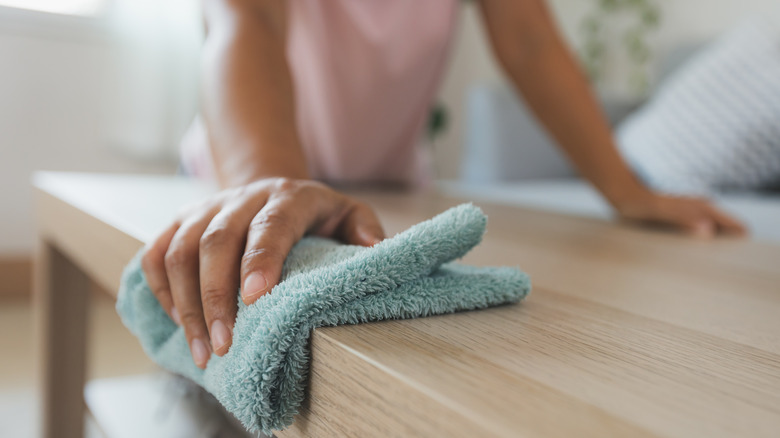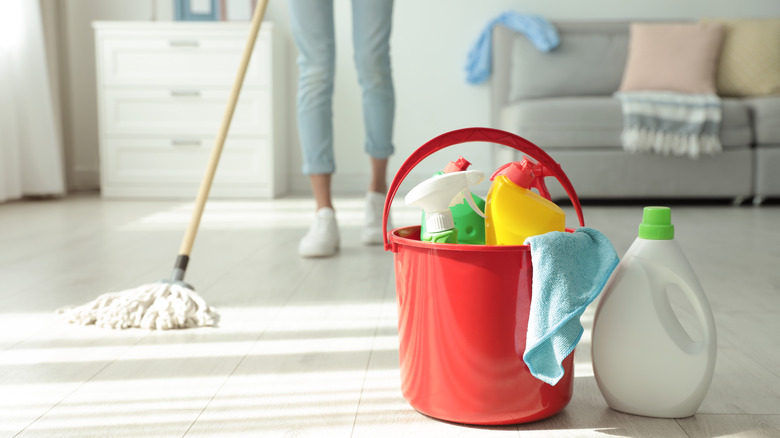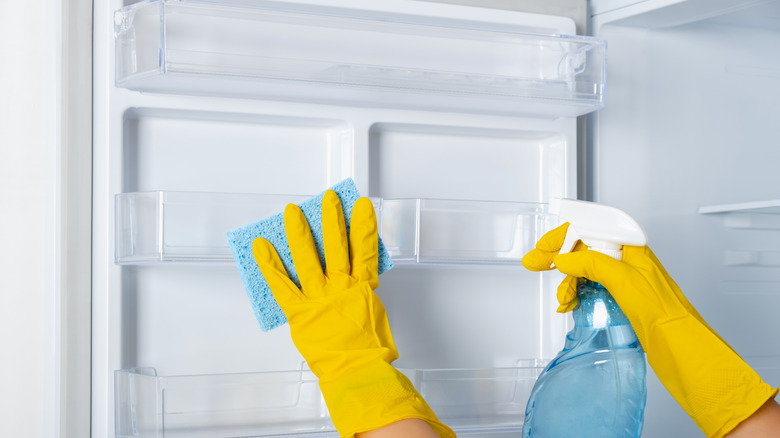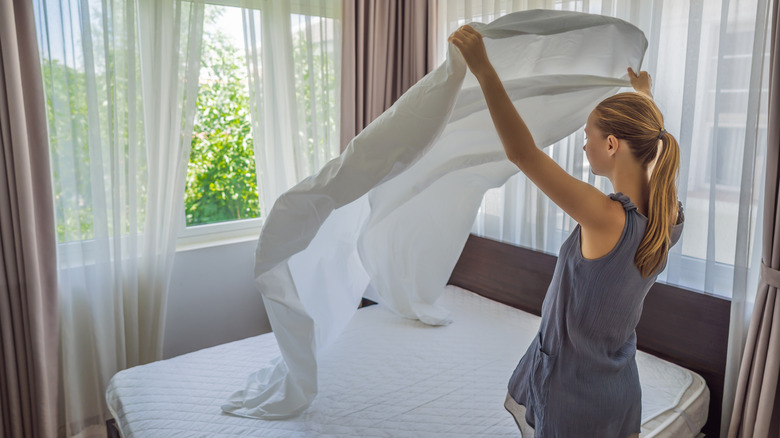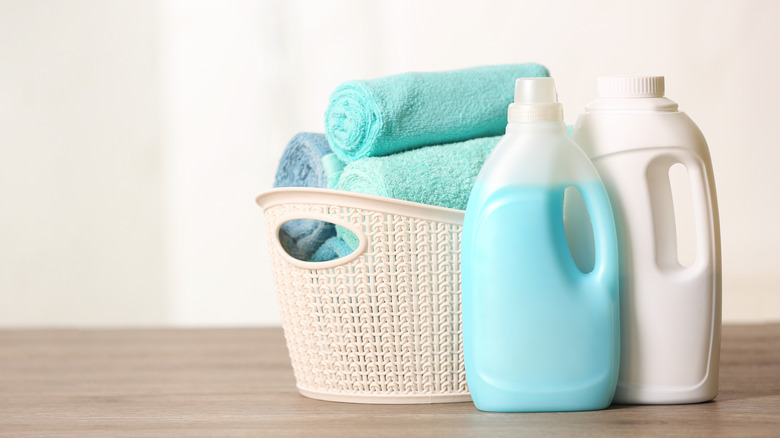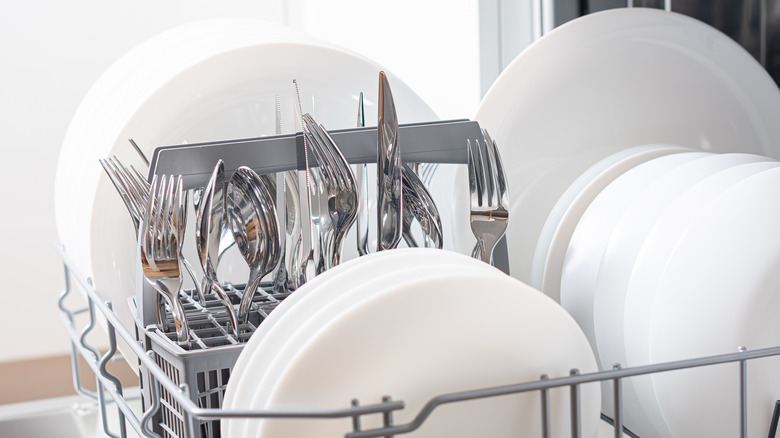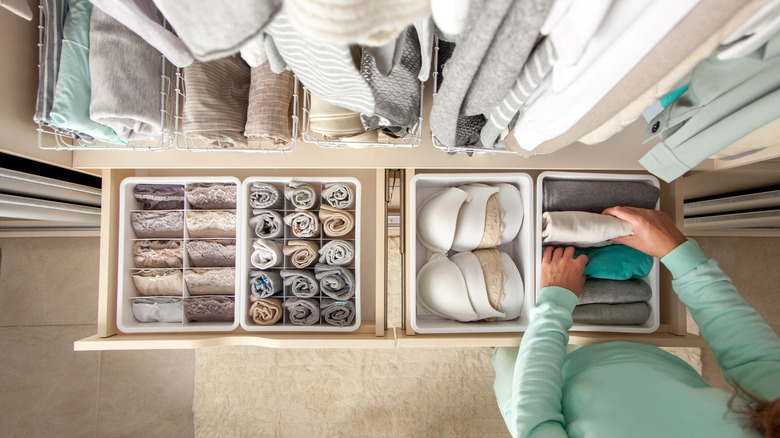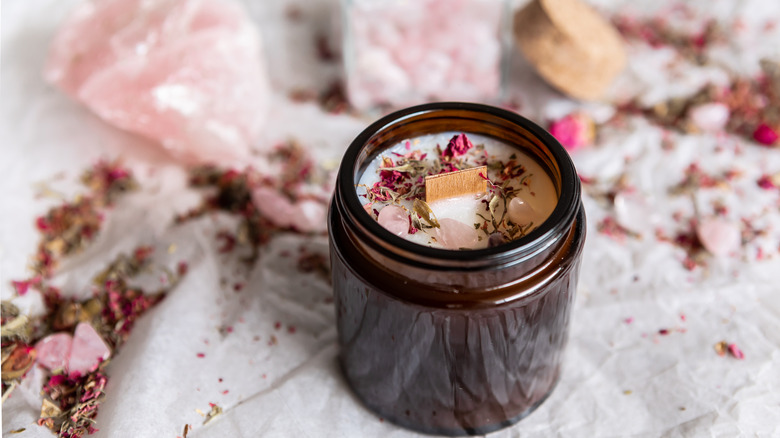How To Spring Clean Your Home
Put away your winter clothes and snow shovels because spring is here! Spring is considered the season of new beginnings and growth. While some people revel in spring cleaning, others think it's overwhelming with too many chores. Spring cleaning shouldn't feel unbearable and difficult. With astute determination and accurate planning, spring cleaning can be uncomplicated and easy to tackle.
If your home has many rooms, it's possible to clean one room at a time to lessen confusion. You don't need to worry about which room to clean first. Creating a checklist to see what needs completing and assigning projects to each family member are good ways to get organized. According to Good Housekeeping, deciding what areas of the home need cleaning or are the dirtiest can help you get started. Want to ensure that your home provides a fresh, neat, and healthy living space? Keep reading for tips and tricks on how to spring clean a home.
Dusting should be a priority
Though it may seem tedious, dusting furniture and wiping down windows should be a top cleaning priority in your home. While it may sound surprising, dust particles are more than just dust. According to Cleaning Club, dust particles contain dead skin cells, dander, and pollen. What's shocking is that dust has microscopic bacteria in it and can cause illnesses and health defects if the home is not kept clean. Due to the sunny days in spring, sunlight can permeate into a room through windows and shine on dust.
When dusting, clean high traffic spots such as coffee tables and dining room tables once a week. Underused bedrooms and guestrooms with furniture and windows can be dusted twice a month or once monthly. Dusting can be made simple by buying furniture spray and window cleaner at a local store. Find a duster or cleaning wipes that won't scatter dust around.
To mop or to vacuum
Confused about whether to mop or vacuum the floors in your home? According to HomelyVille, you should vacuum first before mopping any hard floor surfaces. Mopping first may cause surface-level dirt to just be moved around instead of getting picked up. For hard floor surfaces, vacuum first and mop later. When it comes to rug and carpet cleaning, vacuuming or calling for a steaming service may be the best way to ensure cleanliness. With adult supervision, children can help push the vacuum while the parent is vacuuming and sweep through their bedrooms as well.
To ensure proper cleaning procedures, an adult should take charge of mopping. Be careful when mopping because children shouldn't be around harsh cleaning solutions. Pour warm water into a bucket and mix with the needed cleaning solution. Be sure to mop over the whole surface that needs cleaning. Want to allow fresh air to come into the space? Open a window to let a spring breeze come through and help air dry mopped floors.
Dealing with leaky faucets and clogged toilets
Another household item to mark off the spring cleaning to-do list is checking for leaking faucets. According to WM Henderson, leaky faucets can waste over 30 gallons of water a day. There are a plethora of reasons why faucets leak. For example, there could be a damaged cartridge, broken washers, or a problem with the water pressure. If you have a leaky faucet, deactivate the water, disable faucet handles, and detach valves. Inspect what is wrong and scrub valves with a sanitizing solution or a gentle soap then put the pieces of the faucet back together.
Clogged toilets are also a pain for families living at home. A way to fix a clogged toilet without a plunger is to pour liquid dish soap into the toilet and flush it. Due to its tough stance on oil and grease, liquid dish soap tends to break down dirt and grime easily. If liquid dish soap isn't readily available, cut a bar of soap into pieces and flush it down into the toilet to stop clogging (via Family Handyman). Mixing baking soda with vinegar is another homemade remedy to combat clogging.
A fresh coat of paint
Spring is the perfect time to paint the exterior of a home. It's usually not too humid and hot outside, and the sunshine gives you more motivation to paint. According to Sharper Impressions Painting Company, painting the home's exterior could improve your property value. Not only does the paint cover typical wear and tear, but it can also conceal mildew, mold, and other imperfections. Popular spring paint colors include vibrant shades of green reminiscent of trees and shrubbery. For pops of color, try primary shades such as painting a door fire engine red or painting the trimming of the home in canary yellow.
To add a springtime touch inside the home, consider changing the wallpaper? It's now in style to bring the outdoors inside by filling the walls with tropical flower designs (via World of Wallpaper). You can never go wrong with pasting floral wallpaper onto your bedroom walls. Mix and match fun colors like electric greens and flamingo pinks to create a distinctive color combination.
Getting rid of expired medicine
Spring is in the air, which means common colds and coughs may subside at the end of flu season. According to Vital Record, over-the-counter and prescription medicines that no longer need to be taken or are expired should be disposed of properly. Checking out local take-back programs could be a way to get rid of pills or other medicines. Some pharmacies and clinics participate in these programs. Getting rid of your old medications can help protect pets and children.
If bringing unused prescriptions to a clinic isn't plausible, throw away your over-the-counter prescription pills. Grab Ziploc bags or empty tin containers to hold the medicine before throwing it away in a trash receptacle. Flushing pills down a sink or toilet could be an easy option. Parents should talk with their children, especially teenagers, about pill addiction. Make sure only those prescribed the prescriptions are taking them.
Clean the freezer and refrigerator properly
Toss out any leftover food from the holidays and winter months before spring rolls around. Cleaning out a freezer doesn't have to be tough. According to Taste of Home, it's best to clean the freezer exterior once a week with a rag and dish soap. Throw away leftovers that have freezer burn or are expired. Deep freezer cleaning should occur every few months. Look up handmade cleaning solutions online that work when cleaning freezers, or mix vinegar and water in a spray bottle to wipe down the inside of the freezer. Take out the detachable parts to enable efficient cleaning. After cleaning, reattach the compartments and place unexpired food back inside the freezer.
It's best not to overload your freezer with too much food and other products. Evenly distribute the items in a freezer to allow the cold air to circulate (via Candy). Are you wondering how often you need to clean your refrigerator? It may be wise to clean the outside of your refrigerator once a week with a gentle cleaning solution. When cleaning the inside, remove the compartments and throw away old food. A box of open baking powder will soak up pesky odors and maintain the freshness within a refrigerator.
What to do with old cleaning products
Since spring cleaning is so important, it's a good idea to make sure your cleaning products can get the job done. If you're wondering what to do with cleaning products that are empty or almost empty, there are a couple of solutions. According to Earth911, you can donate unused or mostly used cleaning products to churches and homeless shelters. Be aware of detergent-type products that have an ingredient called triclosan. The ingredient triclosan contributes to antibiotic resistance of bacteria that may harm the inside of pipes if poured down a sink.
Liquid cleaners that are almost empty can be safely poured down a sink since they contain water-soluble ingredients (via Home Storage Solutions 101). Be careful with pouring powder detergent down a sink because it may clump and cause clogging. It's best to pour little by little with water. These cleaning products do expire after one or two years, so check labels to ensure these products are still effective. It may be time to buy new cleaning products to welcome the start of spring.
When to clean bedding
Are you tired of looking at the same old winter bedspread? It's time to replace your sheets for a fresh spring look. Minimalist neutrals, soft pastel colors, and sweet floral prints are perfect during this time of year. How should bed sheets and blankets be cleaned? According to Healthline, it's best to look at the cleaning instructions on the bedding tags. Washing sheets and blankets every two weeks in hot water kills most germs and bacteria and prevents skin infections.
With cells being so microscopic, it's hard to tell what bacteria are on bedsheets. Sweat, skin cells, pollen, and other particles like pet dander can get trapped in bedding and cause bacteria to populate (via Greatist). Wash and disinfect bedding after you've been sick to prevent the spread of disease. If pets are allowed on your bed, wash the bedding frequently. Use your best judgment to determine when bedding needs a wash.
Washing bath towels
Are you dealing with ratty and old bathroom towels? It may be time to chuck them into the trash. According to Martha Stewart, if bathroom towels and washcloths are shedding or have lingering smells, it's best to throw them away and purchase new ones. Depending on the size of the family, you may need to wash your bath towels and washcloths frequently. If they're used continuously and by different people, plan to clean them regularly. Bathroom rugs and kitchen mats should be washed every one to two weeks, depending on foot traffic within the home.
Bacteria, viruses, and fungi live on the skin and could get onto towels (via Self). To prevent the spread of bacteria it's best to invest in extra towels to have on rotation. Check out local stores and online shops to purchase extra towels for your home. There may be special spring sales on the rise!
Diverse ways to use flowers at home
Spring is a time for growth and renewal. Nothing says springtime as seeing colorful flowers bloom outside. According to Apartment Therapy, you can decorate your home with flowers, real or faux. Crafting flowers out of paper cupcake wrappers or tissue paper will create a pretty bouquet for the middle of a dining room table. You can also make faux flowers from paper or clay and display artistic floral decor on a living room wall. Check out craft stores to buy faux flower garlands to hang around an awning.
Want to find real flowers? Go to a local nursery and check out the selection. The employees will help you find specific types of flowers and know how to water and feed the plants. Don't have a local nursery? Look at your backyard and grab a few sprouting dandelions to put in a vase with water, and place it on a tabletop for a simple decoration.
Types of dishware and how to clean
Spring has arrived, and now is the time to purchase new dishes and silverware for your kitchen. According to Sharp Eye, there are a variety of dishware choices to choose from when buying new products. Earthenware plates and cups are ceramics that are fired and glazed. These kinds of products are usually dishwasher safe. Stoneware dishes are more durable compared to earthenware products due to their composition of clay mixed with glass.
To plan amazing get-togethers, style your home with eye-catching dishes like porcelain and bone china (via K!tchn by Grundig). While you can never go wrong with traditional white dishware, it's fun to try out boldly colored plates for parties and other events. Add a special touch to colorful plates by incorporating vibrant cloth napkins or napkin rings. Try to stick with break-resistant pieces for hikes, picnics in the park, and other family outings.
Changing a winter wardrobe to a spring wardrobe
Springtime means putting away those bulky winter coats and chunky cardigans and breaking out the lighter clothes in your closet. How can this switch be accomplished? According to An Indigo Day, one way to transition into a spring wardrobe is to start wearing light sweaters and thin cardigans over flowy maxi and midi skirts. Wear a T-shirt under a cardigan. Want to incorporate spring colors into your wardrobe? Look for neutrals or pastels. Put away the dreary dark colors and add lightness and warm tones to your outfits.
For storage, there are plenty of options to organize a small closet. You can install a built-in closet if there's enough space within the bedroom (via Homes & Gardens). There are also ways to store clothing by creating spaces under stairwells. A dressing room may be a fantastic place to keep clothes if you have too many sweaters and coats. For easy storing, place folded-up sweaters on top of closet shelves.
Spring scents in the home
There's more to spring scents than just buying floral-scented candles. Pack up the pine and evergreen candles and ring in the new season with something fresh. According to StyleCaster, many candles and fragrances are well-suited for spring and will make your house smell amazing. For example, fruit scents like guava and mango are popular. Candles that have notes of mint and eucalyptus fragrances smell just like herb gardens. If you're tired of the typical candle styles, buy bubble candles. They feature a unique design that looks like actual bubbles.
Using reed diffusers in the home is a way to incorporate spring scents without worrying about fire hazards and unattended lit candles. An ideal place to keep a reed diffuser is inside a bathroom to combat unpleasant odors (via Homesick). Keep a reed diffuser in the bedroom on a night table to help you wind down for the night. Lavender and citrus scents are calming and soothing for sleep.
Growing a garden
Designing your own garden might be the perfect spring activity for people with green thumbs. What better time to make a garden other than springtime? Gardening doesn't have to be a complicated task. According to Common Sense Home, one of the first things to check for is fertile soil when making your garden. Ensure there's enough room to grow a garden. The seedlings don't stay small for long, and plants need proper space for growing. To grow succulent fruits and fresh vegetables, place them under consistent direct sunlight. Compared to other herbs and greens, they will not grow effectively in partial shade.
For families with children and pets, try to section off the garden away from high-traffic play areas in the backyard. Sprouting plants could get trampled by running dogs and children if you are not careful. To make gardening a family affair, allow older children to help with digging and planting seeds. Younger children may need adult supervision to prevent them from hurting themselves with the garden supplies.

